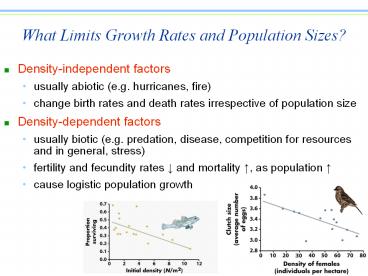What Limits Growth Rates and Population Sizes? - PowerPoint PPT Presentation
1 / 17
Title:
What Limits Growth Rates and Population Sizes?
Description:
usually abiotic (e.g. hurricanes, fire) change birth rates and death rates ... red grouse populations in Britain rise/fall in regular 4-8 yr cycles ... – PowerPoint PPT presentation
Number of Views:60
Avg rating:3.0/5.0
Title: What Limits Growth Rates and Population Sizes?
1
What Limits Growth Rates and Population Sizes?
- Density-independent factors
- usually abiotic (e.g. hurricanes, fire)
- change birth rates and death rates irrespective
of population size - Density-dependent factors
- usually biotic (e.g. predation, disease,
competition for resources and in general, stress) - fertility and fecundity rates ? and mortality ?,
as population ? - cause logistic population growth
2
(No Transcript)
3
Population Dynamics
- Population dynamics changes in populations
through time - some ?, ?, remain unchanged
- some cycle/fluctuate at regular intervals
- population cycles thought to involve
density-dependent factor
4
Population Dynamics
- Some species show regular fluctuations in
population - red grouse populations in Britain rise/fall in
regular 4-8 yr cycles - population cycle is density dependent
- infection rates of roundworm fluctuate depending
on population - untreated populations showed typical dramatic
four-year cycle, treated populations maintained
high densities
5
Population Structure
- Populations age structure has large influence on
population growth - age structure proportion of indiv.
of each
possible age - represented by age pyramids
- Developed nations have more
uniform age
distribution - similar people in most age classes
- result of long periods of
minimal
population growth - populations not expected to
grow
quickly - Sweden
6
Population Structure
- Developing nations often have bottom-heavy age
distribution - dominated by very young individuals
- results when populations undergo
period of rapid
growth - extremely rapid growth
expected to continue
- India
7
Human Population Growth
- Shape of curve is exponential
- ? since 1400
- highest growth rates btwn 1965-70
averaged 2.04/yr - since 1970, growth rate ?
- btwn 1990 and 1995, worldwide
growth rate
averaged 1.46/yr - current rate averages 1.2/yr
2005 6.4 Billion
8
Human Population Growth
- Fertility rates average of children per ?
- current worldwide ave. fertility rate 2.7
children per ? - was 5 in 1950
- replacement rate (ave. fertility rate required
for each ? and ? to produce exactly 1 offspring
that survives to breed) 2.1 - r 0 at replacement rate
- zero population growth (ZPG) results
9
Human Population Growth
- UN Population Division projections of worlds
population in 2050 based on 3 fertility rates
(2.5, 2.1 or 1.7 children per ?) - at 2.5 rate, world population 10.7 B in 2050,
no signs of peaking - at 1.7 rate, world population 7.3 B in 2050,
already peaked
10
Human Population Growth
- Projections drastically altered btwn 1992 and
1998 to account for impact of AIDS - 500-year period of rapid growth coming to end
- changes in fertility and AIDS epidemic will
determine how fast growth rates ? and max.
population size
11
Population Structure
- Geographic structure of populations
- habitat of many sp. restricted despite large
range map - individuals occupy isolated patches (niches)
within broader range - many sp. exist as metapopulation
- metapopulation population made up of many small
populations isolated in fragments of habitat - over time, each population w/i larger
metapopulation wiped out - immigration from nearby habitats recolonize empty
fragments of habitat, thus maintaining overall
stable of individuals - small, isolated populations (even on nature
reserves) unlikely to survive over long term for
this reason
12
(No Transcript)
13
Demography and Conservation
- Conservationists draw heavily on concepts and
techniques from population ecology - design reserves for threatened sp. sizeable
enough to maintain
large populations - systems of small reserves, connected by
corridors, can be
alternative - crucial to preserve some patches of currently
unoccupied habitat
14
Demography and Conservation
- use life tables to make population projections
and guide conservation programs - allows to determine aspects of survivorship and
fecundity that are sensitive to particular sp. - endangered sp. tend to have ? juvenile mortality,
? adult mortality (type III curve) and ?
fecundity, populations sensitive to ? in adult
mortality - b/c young are likely to die anyway
- thus ensure adults dont die
- population growth of sp. w/ type I curve
sensitive to changes in age-specific fecundity - to ? population growth in humans birth control
and delayed 1st pregnancy are advocated
15
(No Transcript)
16
Population Viability Analysis
- Population viability analysis (PVA) model to
estimate likelihood that population will avoid
extinction for period of time - combines demographic models w/ data on geographic
structure and the rate and severity of habitat
disturbance - leadbeaters possum (endangered marsupial)
- w/ migration vs. no migration
- extensive timber harvesting
poses
threat b/c no migration
17
Lessons from Natural and Human-Caused Disasters
- Recovery after Exxon Valdez oil spill of 1989 or
hurricane Hugo - recovery rapid if nearby populations are
available to serve as source of immigration - habitat must be allowed to recover































